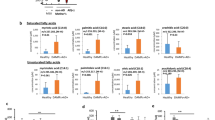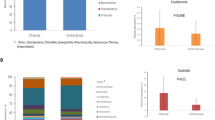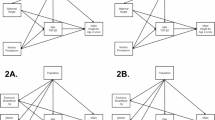Abstract
Background:
Subclinical mastitis (SCM) is a frequent, but poorly characterized entity that may influence immune development of breastfed infants. Mechanisms driving the emergence of SCM and changes in immunological content of human milk during SCM remain to be explored. In this study, the breast milk environment was to describe during SCM.
Methods:
One hundred and ten samples of mature breast milk were collected from 44 healthy, HIV-negative mothers, included in a large infant feeding intervention cohort (ANRS 1271/Vertical Transmission Study). Immune markers related to inflammatory/anti-inflammatory balances and secreted in response to bacterial exposure were explored in SCM breast milk samples (Na/K ratio > 1) and compared to non-SCM controls.
Results:
SCM was observed in 23% of women (95% confidence interval (CI): 21–24) and associated with higher levels of inflammatory markers (β2 microgobulin, PS100A9, TNF-α, IL-6, IL-8, IL-17, and RANTES) and Th1-related cytokines (IL-2R, IL-12p40/70, IFN-α, IFN-γ, CXCL-9, andIP-10). High levels of factors secreted in response to bacteria and lipopolysaccharide (LPS) exposure were observed in SCM breast milk samples (MIP-1α, MIP-1β, LPS binding protein, α-defensins, and antileukoproteinase 1).
Conclusion:
SCM is associated with important changes in breast milk microenvironment, with a proinflammatory/Th1-cytokine predominant profile. During SCM, cytokine imbalances in breast milk may have a notable influence on mucosal immune system of the infant early in life.
Similar content being viewed by others
Log in or create a free account to read this content
Gain free access to this article, as well as selected content from this journal and more on nature.com
or
References
Munblit D, Boyle RJ, Warner JO. Factors affecting breast milk composition and potential consequences for development of the allergic phenotype. Clin Exp Allergy 2015;45:583–601.
Garofalo R. Cytokines in human milk. J Pediatr 2010;156(2 Suppl):S36–40.
Gasparoni A, Chirico G, De Amici M, et al. Granulocyte-marophage colony-stimulating factor in human milk. Eur J Pediatr 1996;155:69.
Garofalo R, Chheda S, Mei F, et al. Interleukin-10 in human milk. Pediatr Res 1995;37(4 Pt 1):444–9.
Bosire R, Guthrie BL, Lohman-Payne B, et al. Longitudinal comparison of chemokines in breastmilk early postpartum among HIV-1-infected and uninfected Kenyan women. Breastfeed Med 2007;2:129–38.
Arsenault JE, Webb AL, Koulinska IN, Aboud S, Fawzi WW, Villamor E. Association between breast milk erythropoietin and reduced risk of mother-to-child transmission of HIV. J Infect Dis 2010;202:370–3.
Shiou SR, Yu Y, Chen S, et al. Erythropoietin protects intestinal epithelial barrier function and lowers the incidence of experimental neonatal necrotizing enterocolitis. J Biol Chem 2011;286:12123–32.
Inch S and von Xylander S. Mastitis: Causes and Management. Geneva, World Health Organization eds, 2000:13–17.
Riordan J, Wambach K. Breastfeeding and Human Lactation. 4th Edition. Sudbury: Jones and Bartlett Publishers; 2010.
Gomo E, Filteau SM, Tomkins AM, Ndhlovu P, Michaelsen KF, Friis H. Subclinical mastitis among HIV-infected and uninfected Zimbabwean women participating in a multimicronutrient supplementation trial. Trans R Soc Trop Med Hyg 2003;97:212–6.
Van de Perre P, Rubbo PA, Viljoen J, Nagot N, Tylleskar T, Lepage P, et al. HIV-1 reservoirs in breast milk and challenges to elimination of breast-feeding transmission of HIV-1. Sci Transl Med 2012,4:143sr143.
Filteau SM, Rice AL, Ball JJ, et al. Breast milk immune factors in Bangladeshi women supplemented postpartum with retinol or beta-carotene. Am J Clin Nutr 1999;69:953–8.
Aryeetey RN, Marquis GS, Timms L, Lartey A, Brakohiapa L. Subclinical mastitis is common among Ghanaian women lactating 3 to 4 months postpartum. J Hum Lact 2008;24:263–7.
Jost T, Lacroix C, Braegger C, Chassard C. Impact of human milk bacteria and oligosaccharides on neonatal gut microbiota establishment and gut health. Nutr Rev 2015;73:426–37.
Neville MC, Allen JC, Archer PC, et al. Studies in human lactation: milk volume and nutrient composition during weaning and lactogenesis. Am J Clin Nutr 1991;54:81–92.
Morton JA. The clinical usefulness of breast milk sodium in the assessment of lactogenesis. Pediatrics 1994;93:802–6.
Aryeetey RN, Marquis GS, Brakohiapa L, Timms L, Lartey A. Subclinical mastitis may not reduce breastmilk intake during established lactation. Breastfeed Med 2009;4:161–6.
Coovadia HM, Rollins NC, Bland RM, et al. Mother-to-child transmission of HIV-1 infection during exclusive breastfeeding in the first 6 months of life: an intervention cohort study. Lancet 2007;369:1107–16.
Bland R, Coovadia H, Coutsoudis A, Rollins N, Newell M. Cohort profile: mamanengane or the Africa centre vertical transmission study. Int J Epidemiol 2010;39:351–60.
Bland RM, Becquet R, Rollins NC, Coutsoudis A, Coovadia HM, Newell ML. Breast health problems are rare in both HIV-infected and HIV-uninfected women who receive counseling and support for breast-feeding in South Africa. Clin Infect Dis 2007;45:1502–10.
Rubbo PA, Tuaillon E, Bolloré K, et al. The potential impact of CD4+ T cell activation and enhanced Th1/Th2 cytokine ratio on HIV-1 secretion in the lungs of individuals with advanced AIDS and active pulmonary infection. Clin Immunol 2011;139:142–54.
Agarwal S, Karmaus W, Davis S, Gangur V. Immune markers in breast milk and fetal and maternal body fluids: a systematic review of perinatal concentrations. J Hum Lact 2011;27:171–86.
Chollet-Hinton LS, Stuebe AM, Casbas-Hernandez P, Chetwynd E, Troester MA. Temporal trends in the inflammatory cytokine profile of human breastmilk. Breastfeed Med 2014;9:530–7.
Gazzolo D, Monego G, Corvino V, et al. Human milk contains S100B protein. Biochim Biophys Acta 2003;1619:209–12.
Mangé A, Tuaillon E, Viljoen J, et al. Elevated concentrations of milk β2-microglobulin are associated with increased risk of breastfeeding transmission of HIV-1 (Vertical Transmission Study). J Proteome Res 2013;12:5616–25.
Regenhard P, Petzl W, Zerbe H, Sauerwein H. The antibacterial psoriasin is induced by E. coli infection in the bovine udder. Vet Microbiol 2010;143:293–8.
Nussenblatt V, Lema V, Kumwenda N, et al. Epidemiology and microbiology of subclinical mastitis among HIV-infected women in Malawi. Int J STD AIDS 2005;16:227–32.
Badiou S, Tuaillon E, Viljoen J, et al. Association between breast milk fatty acids and HIV-1 transmission through breastfeeding. Prostaglandins Leukot Essent Fatty Acids 2016;105:35–42.
Na YJ, Han SB, Kang JS, et al. Lactoferrin works as a new LPS-binding protein in inflammatory activation of macrophages. Int Immunopharmacol 2004;4:1187–99.
Lucas A, Cole TJ. Breast milk and neonatal necrotising enterocolitis. Lancet 1990;336:1519–23.
Claud EC, Lu L, Anton PM, Savidge T, Walker WA, Cherayil BJ. Developmentally regulated IkappaB expression in intestinal epithelium and susceptibility to flagellin-induced inflammation. Proc Natl Acad Sci USA 2004;101:7404–8.
Thomsen AC, Hansen KB, Møller BR. Leukocyte counts and microbiologic cultivation in the diagnosis of puerperal mastitis. Am J Obstet Gynecol 1983;146:938–41.
Burch J, Karmaus W, Gangur V, Soto-Ramírez N, Yousefi M, Goetzl LM. Pre- and perinatal characteristics and breast milk immune markers. Pediatr Res 2013;74:615–21.
Groer M, Davis M, Steele K. Associations between human milk SIgA and maternal immune, infectious, endocrine, and stress variables. J Hum Lact 2004;20:153–8; quiz 159–63.
Tomicić S, Johansson G, Voor T, Björkstén B, Böttcher MF, Jenmalm MC. Breast milk cytokine and IgA composition differ in Estonian and Swedish mothers-relationship to microbial pressure and infant allergy. Pediatr Res 2010;68:330–4.
Hassiotou F, Geddes DT, Hartmann PE. Cells in human milk: state of the science. J Hum Lact 2013;29:171–82.
Riskin A, Almog M, Peri R, Halasz K, Srugo I, Kessel A. Changes in immunomodulatory constituents of human milk in response to active infection in the nursing infant. Pediatr Res 2012;71:220–5.
Cole AM, Ganz T, Liese AM, Burdick MD, Liu L, Strieter RM. Cutting edge: IFN-inducible ELR- CXC chemokines display defensin-like antimicrobial activity. J Immunol 2001;167:623–7.
Sherry B, Espinoza M, Manogue KR, Cerami A. Induction of the chemokine beta peptides, MIP-1 alpha and MIP-1 beta, by lipopolysaccharide is differentially regulated by immunomodulatory cytokines gamma-IFN, IL-10, IL-4, and TGF-beta. Mol Med 1998;4:648–57.
Labéta MO, Vidal K, Nores JE, et al. Innate recognition of bacteria in human milk is mediated by a milk-derived highly expressed pattern recognition receptor, soluble CD14. J Exp Med 2000;191:1807–12.
Buer J, Balling R. Mice, microbes and models of infection. Nat Rev Genet 2003;4:195–205.
Hailman E, Lichenstein HS, Wurfel MM, et al. Lipopolysaccharide (LPS)-binding protein accelerates the binding of LPS to CD14. J Exp Med 1994;179:269–77.
Bingle CD, Vyakarnam A. Novel innate immune functions of the whey acidic protein family. Trends Immunol 2008;29:444–53.
Günther J, Petzl W, Zerbe H, et al. Lipopolysaccharide priming enhances expression of effectors of immune defence while decreasing expression of pro-inflammatory cytokines in mammary epithelia cells from cows. BMC Genomics 2012;13:17.
Manganaro R, Marseglia L, Mamì C, et al. Breast milk sodium concentration, sodium intake and weight loss in breast-feeding newborn infants. Br J Nutr 2007;97:344–8.
Filteau SM, Lietz G, Mulokozi G, Bilotta S, Henry CJ, Tomkins AM. Milk cytokines and subclinical breast inflammation in Tanzanian women: effects of dietary red palm oil or sunflower oil supplementation. Immunology 1999;97:595–600.
Flores M, Filteau S. Effect of lactation counselling on subclinical mastitis among Bangladeshi women. Ann Trop Paediatr 2002;22:85–8.
Nussenblatt V, Kumwenda N, Lema V, et al. Effect of antibiotic treatment of subclinical mastitis on human immunodeficiency virus type 1 RNA in human milk. J Trop Pediatr 2006;52:311–5.
Acknowledgements
We thank the participants and co-workers of the Vertical Transmission Study.
Author information
Authors and Affiliations
Corresponding author
Supplementary information
Supplementary Table S1
(DOCX 17 kb)
Rights and permissions
About this article
Cite this article
Tuaillon, E., Viljoen, J., Dujols, P. et al. Subclinical mastitis occurs frequently in association with dramatic changes in inflammatory/anti-inflammatory breast milk components. Pediatr Res 81, 556–564 (2017). https://doi.org/10.1038/pr.2016.220
Received:
Accepted:
Published:
Issue date:
DOI: https://doi.org/10.1038/pr.2016.220
This article is cited by
-
Validity of an ion selective electrode for measuring human milk sodium and potassium ion levels at point-of-care in lactating mothers with inflammatory breast conditions
International Breastfeeding Journal (2025)
-
Reduction of tumor necrosis factor (TNF) in milk of women receiving anti-TNF antibody
Pediatric Research (2025)
-
Genetic determinants of inflammatory cytokines and their causal relationship with inflammatory disorders of breast: a two-sample Mendelian randomization study
Scientific Reports (2025)
-
Integrated analysis of inflammatory mRNAs, miRNAs, and lncRNAs elucidates the molecular interactome behind bovine mastitis
Scientific Reports (2023)
-
Inflammatory bowel disease in pregnancy and breastfeeding
Nature Reviews Gastroenterology & Hepatology (2023)



